India’s Nuclear Forces 2008
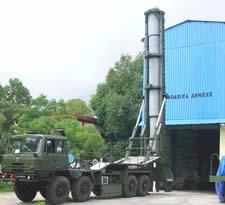 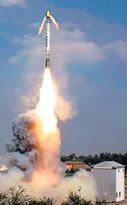 |
| Mystery missile: widely reported as a future sea-launched ballistic missile, is the Shourya launch in November 2008 (right) a land-based mobile missile (left), a silo-based missile, or a hybrid? Images: DRDO |
.
By Hans M. Kristensen
A decade after India officially crossed the nuclear threshold and announced its intention to develop a Triad of nuclear forces based on land-, air-, and sea-based weapon systems, its operational force primarily consists of gravity bombs delivered by fighter jets. Short of the short-range Prithvi, longer-range Agni ballistic missiles have been hampered by technical problems limiting their full operational status [Update Feb. 2, 2009: “Defense sources” quoted by Times of India appear to confirm that the Agni missiles are not yet fully operational]. A true sea-based deterrent capability is still many years away.
Despite these constraints, indications are that India’s nuclear capabilities may evolve significantly in the next decade as Agni II and Agni III become operational, the long-delayed ATV nuclear-powered ballistic missile submarine is delivered, and warhead production continues for these and other new systems.
Our latest estimate of India’s nuclear forces is available from the Bulletin of the Atomic Scientists.
Nuclear Déjà Vu At Carnegie
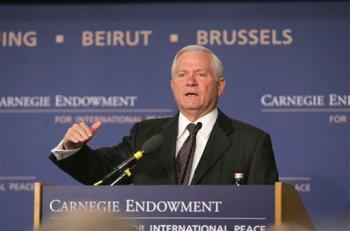 By Ivan Oelrich and Hans M. Kristensen
By Ivan Oelrich and Hans M. Kristensen
Only one week before Barack Obama is expected to win the presidential election, Defense Secretary Robert Gates made one last pitch for the Bush administration’s nuclear policy during a speech Tuesday at the Carnegie Endowment for International Peace.
What is the opposite of visionary? Whatever, that’s the word that best describes Mr. Gates’s speech. Had it been delivered in the mid-1990s it would not have sounded out of place. The theme was that the world is the way the world is and, not only is there little to be done about changing the world, our response pretty much has to be more of the same.
Granted, Gates’s job is to implement nuclear policy not change it but, at a time when Russia is rattling its nuclear sabers, China is modernizing its forces, some regional states either have already acquired or are pursuing nuclear weapons, and yet inspired visions of a world free of nuclear weapons are entering the political mainstream, we had hoped for some new ideas. Rather than articulating ways to turn things around, Gates’ core message seemed to be to “hedge” and hunker down for the long haul. And, while his arguments are clearer than most, this speech is yet another example of faulty logic and sloppy definitions justifying unjustifiable nuclear weapons.
They Do It So We Must Do It Too
Reductions cannot go on forever, Secretary Gates argues because there is still a mission for nuclear weapons. Using language from the Clinton Administration, he says we can reduce our arsenal but we must also “hedge” against unexpected threats. He said, “Rising and resurgent powers, rogue nations pursuing nuclear weapons, proliferation of international terrorism, all demand that we preserve this hedge. There is no way to ignore efforts by rogue states such as North Korea and Iran to develop and deploy nuclear weapons or Russian or Chinese strategic modernization programs.”
While the potential threats he lists are real and must be addressed, how do nuclear weapons address these threats? And even if there were some nuclear component to our responses, the nature of those responses would be so varied that lumping these threats together muddles the issue. A nuclear response to international terrorism? Even if, for example, al Qaeda used a nuclear weapon to attack an American city, what target would we strike back at with a nuclear weapon? The implicit argument of symmetry is unsustainable. Just as we don’t respond to roadside bombs with our own roadside bombs, nor would we respond to chemical attack with chemical weapons or biological attack with biological weapons. We might respond to nuclear attack with nuclear weapons but we should not allow this to be an unstated assumption. The reason rogue nations, let’s say Iran and North Korea, are developing nuclear weapons is not to counter our nuclear weapons but as a counter to our overwhelming conventional capability. They certainly are not making the mistake of implicitly assuming symmetry.
The near universal logical sleight of hand is to make some argument for nuclear weapons, let’s say we need them because North Korea has them, and then, when people nod in agreement that we need nuclear weapons, let slip in the assumption that this implies we need the nuclear arsenal the administration wants. Not so fast. If North Korea has one, perhaps we need two, but that does not mean we need two thousand.
It helps to clarify the typically foggy nuke-think if we remove Russia and China from the picture and ask whether the United States could justify anything near its currently planned nuclear arsenal only to deter and defeat rogue states and terrorists. Of course not. And perhaps we don’t need nuclear weapons for regional scenarios at all, given our overwhelming conventional capabilities. So those odds and ends are thrown into the pot just to scare, not to explain, and not because there is any well thought out strategy for how nuclear weapons are going to stop a terrorist attack on an American city, or why it be an appropriate response to a regional state that doesn’t have the capability to threaten the survival of the United States.
Russia is a very different case: Russian long-range nuclear forces are the only things in the world today that could destroy us as a nation and society, just as we could destroy them. While relations with Russia are not friendly, no conceivable difference between the United States and Russia justifies this mutual hostage relationship. This pointless threat to our very existence persists because of a failure of imagination typified by this speech. In this case, it is the nuclear weapons that are creating the threat, not protecting us from it.
That Ole Warhead Production Fever
Whatever the supposed justification of nuclear weapons, the primary purpose of the Secretary’s speech seemed to be to promote the Reliable Replacement Warhead or RRW but again, his argument rests on hidden (and unjustified) assumptions and, at times, misstatements of fact. The basic premise is that, without testing, we are slowly but certainly losing confidence in the reliability of our nuclear arsenal. He said, “With every adjustment, we move farther away from the original design that was successfully tested when the weapons was first fielded.”
We do? The implication is that we have no other choice, what we could do in 1990 we simply can’t reproduce today, like handing a modern-day native American a hunk of flint and asking him to chip out an arrowhead. Why should this be? With a budget of billions of dollars, we can’t duplicate parts that we could make twenty years ago? We can spend billions on the National Ignition Facility to create the world’s most powerful laser but we can’t reproduce a 1980s O-ring? The problem the Secretary describes is certainly possible and something we have to be alert to but it isn’t inevitable; we can maintain weapons within design margins as long as we want and in the past—pre-RRW—that was precisely the plan. And parts of the weapon that are not the nuclear core of the bomb can be improved and modernized and tested as much as we want.
But Mr. Gates claims that we are slowly and helplessly drifting, “So the information on which we base our annual certification of the stockpile grows increasing dated and incomplete.” This implies the Stockpile Stewardship Program (SSP) has failed. We believe the Secretary is wrong. Everyone we have talked to who is familiar with the enormous effort that has gone into the SSP says that our understanding of nuclear weapons today is substantially greater than it was the day after our last nuclear test. Our knowledge of the aging of nuclear warheads is increasing faster than the warheads are aging. Early uncertainties and concerns about stability, for example, of the plutonium parts of the weapon have been resolved and the parts have been shown to be stable for many decades, if not a century or more. Our computer models are dramatically and significantly more detailed and sophisticated. In fact, one weapon designer has told us that, given a fixed budget, the best investment of your next dollar would never be in a nuclear test but in more inspections, more computer simulations, more replacement of non-nuclear components, more material tests, more frequent tritium replenishment, and so forth.
|
How Many Times Does Congress Have to Say No? |
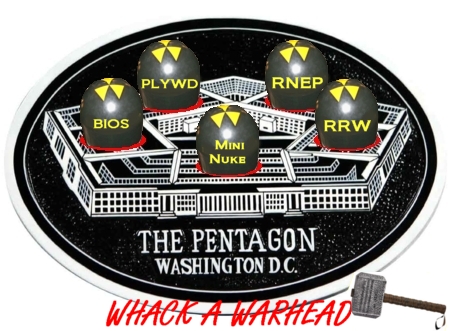 |
| Every time the Pentagon has proposed a new nuclear warhead since the end of the Cold War, Congress has refused to fund it. Now that the RRW appears to have been whacked, what will the next proposal for a new warhead look like? |
.
Aside from the question of the reliability of current warheads, Mr. Gates argues that we still need an RRW because we need to modernize. The British, French, Russians, and Chinese are modernizing so we must too, obviously. Why? Nuclear weapons are a mature technology. There is no new science in nuclear weapons. They are powerful, efficient explosives. They are intended to blow up things and they have specific missions, which typically involve blowing up specific things. If they can accomplish these missions, what is the problem? If the technology, even the weapons, is decades, even centuries old, if they work then they work. Nuclear weapons are not fighter planes or tanks or submarines, duking it out on a battlefield with the enemy’s opposite number, so our nuclear weapons should be evaluated with regard to the targets they are expected to destroy, not anyone else’s nuclear weapons. They can destroy the targets. We’re done.
The important factor is not the warhead but the delivery vehicle that is intended to bring the warhead to the target. And the reason the United States is not producing new nuclear weapons while Russia and China do is not because they can and we can’t, or they’re ahead and we’re behind, as the Secretary indicated. Rather, the United States has not been producing new nuclear weapons because it didn’t have to – the existing ones are more than adequate – and because not producing has been seen as much more important to U.S. foreign policy objectives. And if Russian and Chinese warhead production is a problem, why not propose how to influence them to change rather than advocating that we repeat their mistake?
The final argument for the RRW is that the US must maintain a nuclear production industry and the RRW is grist for that mill. But many of the RRW technologies and capabilities were developed by the very SSP that Gates now implies is failing. Six years ago – before they came up with RRW after having failed to get permission to build the Precision Low-Yield Weapon Design (PLYWD) and the Robust Nuclear Earth Penetrator (RNEP) – the National Nuclear Security Administration assured Congress: “We believe the life extension programs authorized by the Nuclear Weapons Council for the B61, W80, and the W76 will sufficiently exercise the design, production and certification capabilities of the weapons complex” (emphasis added). That assurance was given after the Foster Panel recommended, “developing new designs of robust, alternative warheads.” Now the claim suddenly is that the life extension programs do not sufficiently exercise the weapons complex. At least get the argument straight.
What’s Around the Corner?
We would be more sympathetic to the production argument if the fundamental minimal needs of the nuclear production industry were better thought out and justified, but what we see is an effort to maintain a slimmed down version of what we have without thinking through what we need. In fact, if maintaining the production industry is the core objective, we would have expected the administration to ask for an RRW design that doesn’t need a complex production industry, one that is extremely simple, perhaps using uranium rather than plutonium, perhaps a clunky design but one sure to work that does not require any sophisticated skills that must be maintained in standby in perpetuity.
We’re concerned that in the end Congress will accept a beefed-up life extension program – they seem to have already found a name for it: Advanced Certification Program – that will relax the restrictions for what modifications can be made to existing warheads in order to incorporate as much as the RRW concept as possible and add new capabilities if necessary. Unless the next president significantly changes the nuclear guidance for what the Pentagon is required to plan for, RRW-like proposals will likely continue to make it harder to create a national consensus on the future role of nuclear weapons. And Barack Obama has not explicitly rejected the RRW, but said he does “not support a premature decision to produce the RRW” and “will not authorize the development of new nuclear weapons and related capabilities.” Enhanced life-extended warheads could fit within such a policy.
In the end, justifying the nuclear weapons production industry is shaky because the justification for the weapons themselves is shaky, resting on assertion and Cold War momentum – as Gates’ speech illustrated – more than on rigorous assessments of missions and the security of the nation.
The Secretary’s speech was a disappointing missed opportunity. We are a bit perplexed about why he gave it and gave it now. Perhaps he is putting down a marker for a debate he expects in the next administration and Congress. We welcome that debate because we believe that, with careful attention to definition and no hidden assumptions, the arguments for nuclear weapons fade away.
Nuclear Weapons Stockpile Secrecy And Confusion
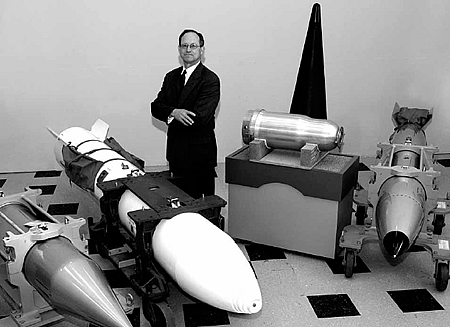 |
| Sorry, can’t tell! The size of the nuclear weapons stockpile is secret, but not hard to figure out. |
.
By Hans M. Kristensen
In a letter to the editor in Boston Globe, Thomas D’Agostino, the administrator of the National Nuclear Security Administration (NNSA), writes that the United States is reducing its nuclear weapons and that, “Currently, the stockpile is the smallest it has been since the Eisenhower administration.”
That statement leaves considerable confusion about the size of the stockpile. If “since the Eisenhower administration” means counting from 1961 when the Kennedy administration took over, that would mean the stockpile today contains nearly 20,000 warheads. If it means counting from the day the Eisenhower administration took office in 1953, it would mean fewer than 1,500 warheads.
Why leave an order of magnitude of confusion about the size of the nuclear weapons stockpile?
Stockpile History
Neither number is correct. The actual stockpile size today, based on what I and my colleagues at NRDC can piece together, is approximately 5,300 warheads, or roughly the size of the stockpile in 1957 (see Figure 1). That is certainly a lot less than the 1980s, but it’s also an awful lot for the 21st century.
|
Figure 1: |
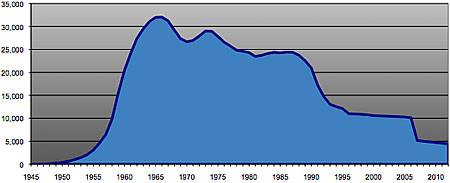 |
| The size of the U.S. nuclear weapons stockpile has declined ever since the mid-1960s, and currently includes roughly 5,300 warheads, or approximately the size of the stockpile in 1957. When all announced reductions have been implemented in 2012, the size of the stockpile will have returned to the 1956-level of approximately 4,600 warheads. |
.
Mr. D’Agostino is, of course, in a bind because even though he and others at NNSA might agree that the stockpile size could be declassified, the Department of Defense insists it has to be kept secret. Even disclosing the number of nuclear weapons dismantled each year is prohibited, because it could help reveal the size of the nuclear stockpile. As it turns out, warhead dismantlement during the Bush administration has been the lowest since 1956 (see Figure 2).
|
Figure 2: |
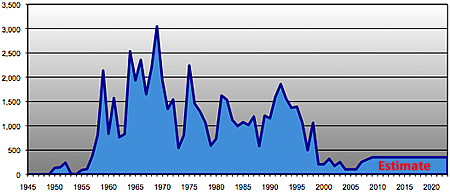 |
| Even with the recent announcement of an “astounding 146 percent increase” in warhead dismantlement in 2007 and another 20 percent in 2008, the Bush administration’s dismantlement rate remains the lowest of any administration since 1956. |
.
What motivates this secrecy, other than the usual resistance to transparency in nuclear weapons matters, is preparation for a world of smaller nuclear arsenals a decade or two from now, when the United States might have reduced the number of deployed nuclear weapons to perhaps 1,000 or even less. In such a world, some fear, Russia or China might suddenly turn for the worse and secretly increase their nuclear arsenals and change the strategic balance. Knowing how many nuclear weapons the United States holds in reserve to increase the deployed force could, so the argument goes, greatly affect the U.S. ability to act and protect its allies. It’s kind of like reverse psychology: With fewer nuclear weapons it matters more what adversaries know.
A Policy For The Future
Keeping the size of the stockpile secret might have been a valid national security requirement during the Cold War, even though I don’t find the arguments very convincing. But today, nearly two decades after the Cold War ended, it is fair to ask: So what if potential adversaries know how many nuclear weapons the United States has?
If my colleagues and I can make a fairly accurate estimate, so can Russia and China. How can anyone in this day and age seriously argue that it matters that they’re 10-100 warheads off? And isn’t it better that they and our allies know the truth, instead of making their own assumptions?
More importantly, however, is that the stockpile and dismantlement numbers today are very effective instruments for showing the world that the United States is not building up its nuclear arsenal. They reassure allies and deprive adversarial hardliners the uncertainty they need to argue for nuclear modernization. Stockpile transparency, not worst-case breakout and warfighting theories, combined with an aggressive and sustained foreign policy effort to engage other nuclear weapon states, should be the priority for the next administration.
Background Information: Status of World Nuclear Forces 2008 | US Nuclear Force 2008 | Russian Nuclear Forces 2008 | Chinese Nuclear Forces 2008
State Department Arms Control Board Declares Cold War on China
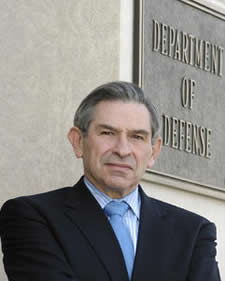
After planning the war against Iraq, former Assistant Secretary of Defense Paul Wolfowitz now heads the State Department’s International Security Advisory Board that recommends a Cold War against China.
By Hans M. Kristensen
A report from an advisory board to Secretary of State Condoleezza Rice has recommended that the United States beefs up its nuclear, conventional, and space-based posture in the Pacific to counter China.
The report, which was first described in the Washington Times, portrays China’s military modernization and intentions in highly dramatic terms that appear go beyond the assessments published so far by the Defense Department and the intelligence community.
Although the Secretary of State asked for recommendations to move US-Chinese relations away from competition and conflict toward greater transparency, mutual confidence and enhanced cooperation, the board instead has produced a report that appears to recommend policies that would increase and deepen military competition and in essence constitute a small Cold War with China.
China’s “Creeping” Nuclear Doctrine
Although the report China’s Strategic Modernization – written by the International Security Advisory Board (ISAB) – deals with China’s overall military modernization, its focus is clearly on nuclear forces. What underpins China’s expansion of its offensive nuclear capabilities, the report says, is an “emerging creep toward a Chinese assured destruction capability” to create a “mutual vulnerability relationship” with the United States.
The objective is, an interpretation the authors say is supported by “numerous Chinese military statements,” for Beijing to get enough nuclear capability “to subject the United States to coercive nuclear threats to limit potential US intervention in a regional conflict” over Taiwan and oilfields in the South China Sea.
Yet “assured destruction,” to the extent that means confidence in a retaliatory capability against the United States and Russia, has been Chinese nuclear policy for decades. Increasing US and Russian nuclear capabilities, however, convinced Chinese planners that their deterrent might not survive. The current deployment of three long-range ballistic missile versions of the mobile DF-31 is supposed to restore the survivability of their strategic deterrent.
The “mutual vulnerability relationship” the authors say China is trying to create to deter the United States from defending Taiwan or limit US escalation options is a curious argument because it implies that the United States has not been vulnerable to Chinese nuclear threats in the past. In fact, US bases and allies in the Western Pacific have been vulnerable to Chinese attacks since the 1970s and the Continental United States since the early 1980s.
It is tempting to read the authors’ use of the terms “assured destruction” and “mutual vulnerability relationship” as borrowed components of “mutual assured destruction,” or MAD, the term for the nuclear relationship that existed between the United States and the Soviet Union during much of the Cold War.
But in responding to China’s nuclear modernization and policy, it is very important not to resort to Cold War-like worst-case analysis. To that end, two of the best analyzes on Chinese nuclear policy are Iain Johnston’s China’s New ‘Old Thinking:’ The Concept of Limited Deterrence, and Michael S. Chase and Evan Medeiros’ China’s Evolving Nuclear Calculus: Modernization and Doctrinal Debate. The ISAB members should read them.
Misperceptions or Just Out of Touch
The report contains several claims about Chinese nuclear forces and recommendations for counter-steps that appear out of sync with what the US intelligence community has stated and steps that the US has already taken. Some of the most noteworthy are listed below followed by my remarks:
* “By 2015, China is projected to have in excess of 100 nuclear-armed missiles…that could strike the United States.” Actually, the projection the intelligence community has made in public is for 60 ICBMs by 2010 and “about 75 to 100 warheads deployed primarily against the United States” by 2015. The ISAB report talks about targeting of the US “homeland.” If that includes Guam, then the force could reach a little above 100 by 2015 (it’s about 70 today). If “homeland” means the Continental United States, which has been the focus of the intelligence community’s projection, then a force carrying 75-100 warheads would likely include 20 DF-5As and 40-55 DF-31A. China so far is thought to have deployed fewer than 10 DF-31As.
* Some of the missiles “may be MIRVed” by 2015. What the intelligence community has said is that China has had the capability to MIRV its silo-based missiles for years but has not yet done so. MIRV on the mobile missiles, however, represents significant technical hurdles and “would be many years off,” according to the CIA, and “would probably require nuclear testing to get something that small.” Instead, if Chinese planners determine that the US missile defense system would degrade the effectiveness of the Chinese force, they “could use a DF-31 type RV for a multiple-RV payload for the CSS-4 in a few years,” the CIA stated in 2002. Even so, a multiple-RV payload is not necessarily the same as MIRV.
* China’s “substantial expansion” of its nuclear posture “includes development and deployment of…tactical nuclear arms, encompassing enhanced radiation weapons, nuclear artillery, and anti-ship missiles.” That would certainly be news if it were true, but the intelligence community hasn’t talked much about Chinese tactical nuclear weapons and what it has said has been contradictory, ranging from China might have some to “there is no evidence” that they have any. Several of China’s tests reportedly involved enhanced radiation or tactical warhead designs, but whether China is working on fielding tactical nuclear weapons has not been confirmed. China did conduct what appeared to be operational tests of tactical bombs in the past, which they might have fielded, but ISAB does not mention bombs.
* China’s modernization includes “a growing capability for Conventional Precision Strike and other anti-access/area-denial capabilities” including “submarine-launched ballistic missiles.” That China would use nuclear missiles on its future strategic submarines for “anti-access/area-denial” capabilities is news to me and would, if it were true, represent a dramatic change in Chinese nuclear policy. But I haven’t seen anything that suggests its true, and the overwhelming expectation is that China will use its SSBNs as a retaliatory strike force, if and when they manage to operationalize it.
* The US “should reaffirm its formal security guarantees to allies, including the nuclear umbrella.” The US does that regularly when it extends the security agreement with South Korea and Japan. In addition, in response to the North Korean nuclear test in October 2006, President Bush reaffirmed that “The United States will meet the full range of our deterrent and security commitments.” One week later, Secretary of State Condoleezza Rice arrived in Tokyo where she emphasized the nuclear component by saying that “the United States has the will and the capability to meet the full range – and I underscore full range – of its deterrent and security commitments to Japan.”
* The US should “pursue new missile defense capabilities, including taking full advantage of space,” to counter China’s growing nuclear capability. For a State Department advisory committee to recommend using missile defenses to counter Chinese nuclear missiles is, to say the least, interesting given that the State Department has publicly stated and assured the Chinese that the missile defense system “it is not directed against China.”
* The US should “publicly reaffirm its commitment to retain a forward-based US military presence in East Asia.” The US has actually done that quite explicitly over the past seven years by shifting the majority of its aircraft carrier battle groups and nuclear attack submarines to bases in the Pacific, by beginning to forward deploy nuclear attack submarines to Guam, by sending strategic B-2 and B-52 bombers on extended deployments to Guam, and by forward deploying the nuclear-powered aircraft carrier USS George Washington (CVN-75) to Japan. The Pentagon describes the recent Valiant Shield exercises as “the largest Pacific exercise since the Vietnam War.”
|
Pacific Exercises Now Biggest Since Vietnam War |
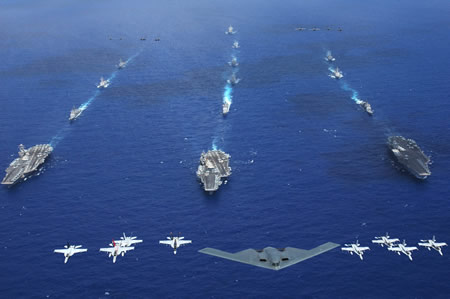 |
| While ISAB recommends increasing the US military posture in the Pacific to counter China, the Pentagon says recent exercises, including the thee carrier battle group Valiant Shield 06, are now the largest since the Vietnam War.
|
.
* “For almost two decades, the United States has allowed its nuclear posture – its stockpile, infrastructure, and expertise – to deteriorate and atrophy across the board.” Although the stockpile is much smaller compared with the Cold War and industrial-scale production of new nuclear warheads has ceased, ISAB’s characterization of the US nuclear posture is way off.
Instead, during the nearly two decades the authors describe (assuming that means since 1990), the US has deployed eight new SSBNs, deployed 336 Trident II D-5 SLBM on its entire SSBN fleet, deployed 21 B-2 stealth bombers, deployed the Advanced Cruise Missile, deployed the hard-target kill W88 warhead (including in the Pacific), deployed three modified nuclear weapons (B61-10, B61-11 and W76-1), completely overhauled the Minuteman III ICBM force, deployed two new classes of nuclear-powered attack submarines capable of launching nuclear cruise missiles, deployed a modern nuclear command and control system with new satellites and command centers, modernized the Strategic War Planning System (now called ISPAN), created a “living SIOP” strategic nuclear war plan with broadened targeting against China and new strike options against regional adversaries, and built a multi-billion dollar Science Based Stockpile Stewardship Program to certify the reliability of the nuclear stockpile without nuclear testing and provide weapons designers with unprecedented knowledge about warhead aging and the skills and tools to refurbish existing warheads or build modified ones.
Where Are The Non-Military Policy Recommendations?
One of the most striking features of the report is its almost complete focus on military options and the absence of other policy components. It contains no analysis of or recommendations for how to engage China on nuclear arms control or confidence building measures to limit or influence the nuclear modernization, operations and policy. It is almost as if there must be another unknown chapter to the report.
Although the authors believe there are a number of measures the US should take to reduce the prospect for misunderstanding and the chance of miscalculation, those recommendations are few and limited to continuing existing Track II discussions, military-to-military contacts, and asking the Chinese to be more transparent.
The report concludes that China does not desire a conflict with the United States, and describes a disconnect between the political and military leadership, and a “clear paranoia and misperceptions about US intentions….” Without presenting any analysis, it concludes that the US ability to shape or change Chinese choices related to its strategic modernization may be “very constrained” and that there is no point in trying to “educate” the Chinese.
On the contrary, the report concludes that the US should “reject” Chinese arms control proposals because they will constrain US military freedom. And US arms transfer to allied countries in the region “should be an important dimension of US non-proliferation policy.” Indeed, the “most important” policy recommendation is for the United States to “demonstrate its resolve to remain militarily strong….”
And in a recommendation blatantly “imported” from the Cold War, the authors say the US should “focus” its research and development on “high technology military capabilities” that China doesn’t have to “demonstrate to Beijing that trying to get ahead of the United States is futile (much the way SDI did against the Soviet Union.”
The report essentially capitulates on non-military policy options toward China.
So What Exactly Was ISAB Asked To Do?
The advisory board was asked to come up with ideas that could “move the US-China security relationship toward greater transparency and mutual confidence, enhance cooperation, and reduce the likelihood of misunderstanding or miscalculation that can contribute to competition or conflict.” That’s a quote!
Instead, the authors appear to have produced a paper that would – if implemented – likely move the US-Chinese security relationship in the opposite direction by deepening military competition and mistrust.
Indeed, the review looks more like the kind one would expect from the Pentagon rather than the State Department, which is supposed to pursue a wider set of policies and different agenda than the military. It is all the more striking given that the charter for ISAB – which used to be called the Arms Control and Nonproliferation Advisory Board (ACNAB) – describes that the board is supposed to “advise with and make recommendations to the Secretary of State on United States arms control, nonproliferation, and disarmament policies and activities.”
The Secretary’s hope has been for ISAB to provide “independent insight, advice, and innovation,” and serve as “a single advisory board, dealing with scientific, military, diplomatic, political, and public diplomacy aspects of arms control, disarmament, international security, and nonproliferation, would provide valuable independent insight and advice….”
Concluding Remarks
The militaristic focus of ISAB’s report and its lack of recommendations for arms control and broader public diplomacy to defuse rather than continuing and deepening the competitive and mistrustful relationship between the United States and China suggest that ISAB has failed to live up to its charter.
No matter what one might think of China’s military modernization, the ISAB appears instead to have drawn up a very effective plan for a Cold War with China.
Although the authors correctly state up front that the US-Chinese relationship “differs fundamentally from the US-Soviet relationship and the strategic rivalry of the Cold War,” they nonetheless land on a set of recommendations and observations that strongly resemble a China-version of the Reagan administration’s aggressive military posture against the Soviet Union.
If implemented or allowed to color US policy toward China, the policy recommendations would continue and very likely lead to a deepening of military competition and adversarial relationship between the United States and China – exactly the opposite of what the Board was asked to come up with. It is precisely reports like this that create the “deep paranoia and misperceptions about US intentions” in the Chinese military.
Secretary of State Condoleezza Rice should denounce the ISAB report to make it clear that the core of US policy toward China is not containment and Cold War posturing. And one of the first acts of the next Secretary should be to appoint a new advisory board that can – and will – develop recommendations that can “move the US-China security relationship toward greater transparency and mutual confidence, enhance cooperation, and reduce the likelihood of misunderstanding or miscalculation that can contribute to competition or conflict.” Mission not accomplished!
Background Information: ISAB Report: China’s Strategic Modernization | Chinese Nuclear Forces 2008 | US Nuclear Forces 2008 | FAS/NRDC Report: Chinese Nuclear Forces and U.S. Nuclear War Planning
Nuclear Policy Paper Embraces Clinton Era “Lead and Hedge” Strategy
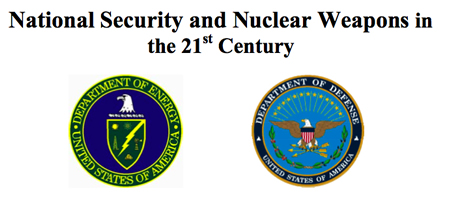
By Hans M. Kristensen
The new nuclear policy paper National Security and Nuclear Weapons in the 21st Century published quietly Tuesday by the Defense and Energy Departments embraces the “lead and hedge” strategy of the first Clinton administration for how US nuclear forces and policy should evolve in the future.
Yet the “leading” is hard to find in the new paper, which seems focused on hedging.
Instead of offering different alternative options for US nuclear policy, the paper comes across as a Cold War-like threat-based analysis that draws a line in the sand against congressional calls for significant changes to US nuclear policy.
Strong Nuclear Reaffirmation
The paper presents a strong reaffirmation of an “essential and enduring” importance of nuclear weapons to US national security. Russia, China and regional “states of concern” – even terrorists and non-state actors – are listed as justifications for hedging with a nuclear arsenal “second to none” with new warheads that can adapt to changing needs.
Even within the New Triad – a concept presented by the 2001 Nuclear Posture Review as a way to decrease the role of nuclear weapons and increasing the role of conventional weapons and missile defense – the new paper states that nuclear weapons “underpin in a fundamental way these new capabilities.”
In defining the role of nuclear weapons, the paper borrows from and builds on statements, guidance and assertions about the role of nuclear weapons issued by the Clinton and Bush administrations during the past 15 years. This consensus seeking style presents a strong reaffirmation of the continued importance – even prominence – of nuclear weapons in US national security.
Threat-Based Analysis After All
Officials have argued for years that US military planning is no longer based on specific threats and that the security environment is too uncertain to predict them with certainty. But there is nothing uncertain about who the threats are in this paper, which seems to place renewed emphasis on threat-based analysis. The earlier version from 2007 did not mention Russia and China by name, but both countries and their nuclear modernizations are prominently described in the new paper.
Russia is said to have a broad nuclear modernization underway of all major weapons categories, increased emphasis on nuclear weapons in its national security policy and military doctrine, possess the largest inventory of non-strategic nuclear weapons in the world, and re-incorporated theater nuclear options into its military planning. This modernization, resumption of long-range bomber patrols, threats to target US missile defense systems in Europe with nuclear weapons, have created “considerable uncertainty” about Russia’s future course that makes it “prudent” for the US to hedge.
China is said to be the only major nuclear power that is expanding the size of its nuclear arsenal, qualitatively and quantitatively modernizing its nuclear forces, developing and deploying new classes of missiles, and upgrading older systems. The paper repeats the assessment from the 2006 Quadrennial Defense Review that “China has the greatest potential to compete militarily with the United States and field disruptive technologies that could, over time, offset traditional U.S. military advantages.” To that end, the paper indirectly points to China as having influenced the US force level planned for 2012 in “retaining a sufficient margin over countries with expanding nuclear arsenals….”
Regional “states of concern” – formerly known as rogue states – with (or developing) weapons of mass destruction are also highlighted in the paper as an enduring mission for US nuclear weapons. This broadened role for US nuclear weapons, which evolved during the 1990s and in 2003 led to incorporation of nuclear strike options into the US strategic war plan, focuses on Iran, North Korea and Syria. But the paper warns that a significant change in the “alignment among states of concern” in the future may require “adjustments to US deterrent capabilities.”
“Violent extremists and non-state actors” – commonly known as terrorists – are also listed as potential missions for US nuclear weapons. Most analysts agree that terrorists cannot or do not need to be affected by nuclear threats, so the paper instead declares that it is US policy “to hold state sponsors of terrorism accountable for the actions of their proxies.”
In addition to these potential threats, the paper describes how regional dynamics lead other nations, “such as India and Pakistan, to attach similar significance to their nuclear forces.” Israel is not mentioned in the paper.
And if all of this fails to impress, the paper also includes France and the United Kingdom to show that they have already committed themselves to extending and maintaining modern nuclear forces well into the 21st century.
These trends “clearly indicate the continued relevance of nuclear weapons, both today and in the foreseeable future,” the paper concludes. Therefore, it asserts, it is prudent that the United States maintains a viable nuclear capability that is “second to none” well into the 21st century.
Sizing a “Second to None” Nuclear Arsenal
“Second to none” means a US arsenal that is better than Russia’s arsenal. At the same time, the paper states that the criteria for sizing the US arsenal “are no longer based on the size of Russian forces and the accumulative targeting requirements for nuclear strike plans.” This has been said before and has confused many; some officials have even claimed that target plans do not affect the size of the arsenal at all. So the paper adds a lot of new information – probably the most interesting and valuable part of the paper – to clarify the situation:
| “Prior to the 2001 Nuclear Posture Review, force sizing considerations were based on target defeat criteria with the objective of rendering a nuclear-armed adversary incapable of prosecuting conflict, and terminating any conflict on terms favorable to the United States. U.S. Forces were sized to defeat all credible nuclear-armed adversary targets, and the United States retained a small reserve to ensure sufficient capability to deter further aggression in any post-exchange, post-conflict environment. Weapons were dedicated to specific targets, and the requirements for target defeat did not change dramatically year-to-year….” The 2001 NPR “made distinctions among the contingencies for which the United States must be prepared. These contingencies were categorized as immediate, potential, or unexpected….” “Instead, the size of the U.S. nuclear force is now based on the ability of the operationally deployed force, the force structure, and the supporting nuclear infrastructure to meet a spectrum of political and military goals. These considerations reflect the view that the political effects of U.S. strategic forces, particularly with respect to both central strategic deterrence and extended deterrence, are key to the full range of requirements for these forces and that those broader goals are not reflected fully by military targeting requirements alone.” |
.
Still confused? What I think they are trying to say is that the target sets for some contingencies no longer have to be covered by operationally deployed nuclear warheads on a day-by-day basis.
What has permitted this change is not a deletion of strike plans against the Russian target base per ce (which has shrunk considerably since the 1980s), but rather the extraordinary flexibility that has been added to the nuclear planning system and the weapons themselves over the past decade and a half. This flexible targeting capability – which ironically was started in the late 1980s in an effort to hunt down Soviet mobile missile launchers – has since produced a capability to rapidly target or retarget warheads in adaptively planned scenarios. Put simply, it is no longer necessary to “tie down” entire sections of the force to a particular scenario or group of targets (although some targets due to their characteristics necessitate use of certain warheads).
The more flexible war plan that exists today, which the 1,700-2,200 operational deployed strategic warhead level of the SORT agreement is sized to meet, is “a family of plans applicable to a wider range of scenarios” with “more flexible options” for potential use “in a wider range of contingencies.” And although they are no longer the same kind of strike plans that existed in the 1980s, some of them still cover Russia to meet the guidance of the Nuclear Weapons Employment Policy document from 2004:
| “U.S. nuclear forces must be capable of, and be seen to be capable of, destroying those critical war-making and war-supporting assets and capabilities that a potential enemy leadership values most and that it would rely on to achieve its own objectives in a post-war world.” |
.
Concluding Observations
The political motivation for this paper is Congress’ demand for a comprehensive review of US nuclear policy before considering whether to approve industrial-scale production of new nuclear warheads. To that end, the paper presents the Defense and Energy department’s nuclear weapons requirement “logic” in an attempt to create a basis for anyone who is considering changing US nuclear weapons policy, strategy, and force structure.
The paper says the US has already made “historic reductions” in its deployed nuclear forces – a fact given the Cold War only happened once and has been over for two decades – and comes tantalizingly close to acknowledging that the warhead level set by the SORT agreement essentially is the START III level framework agreed to by Presidents Clinton and Yeltsin in Helsinki in 1997.
Indeed, by closely and explicitly aligning itself with policies pursued by the Clinton and first Bush administrations, the paper seeks to tone down the controversial aspects of the current administration’s nuclear policy and portray it as a continuation of long-held positions. Whether that will help ease congressional demands for change remains to be seen.
Yet for a paper that portrays to describe the role of nuclear weapons “in the 21st century” – a period extending further into the future than the nuclear era has lasted so far – is comes across as strikingly status quo. A better title would have been “in the first decade of the 21st century.”
It offers no options for changing the role of nuclear weapons or reducing their numbers beyond the SORT agreement – it even states that “no decisions have been made about the number or mix of specific warheads to be fielded in 2012.” The only option for reducing further, the paper indicates, is if Congress approves production of new nuclear warheads (including the RRW that Congress has rejected) that can replace the current types. And even that would require a production far above the currently planned level.
The central message of the paper seems to be that two decades of nuclear decline is coming to an end and that all nuclear weapon states will retain, prioritize, and modernize their nuclear forces for the indefinite future. The US should follow their lead, the paper indicates, and “maintain a credible deterrent at these lower levels” for the long haul. To do that, the United States needs nuclear forces “second to none” “that can adapt to changing needs.”
Background Information: National Security and Nuclear Weapons in the 21st Century | US Nuclear Forces 2008 | 2001 Nuclear Posture Review Report (reconstructed)
French Nuclear Forces
 |
| Sarkozy says he wants to be more open about France’s nuclear arsenal “than anyone ever has been” about theirs. OK, does the aircraft carrier Charles de Gaulle still carry nuclear weapons in peacetime? |
.
By Hans M. Kristensen
The French nuclear weapons arsenal currently includes approximately 300 warheads, according to our latest estimate published in the Bulletin of the Atomic Scientists. Roughly 80 percent of the warheads are for delivery by three ballistic missiles submarines. The remaining warheads are on cruise missiles for delivery by land- and sea-based strike aircraft. The total arsenal is expected to decrease further to some 290 warheads in the next few years.
Although President Nicolas Sarkozy declared in March 2008 that he had “decided that France could and should be more transparent with respect to its nuclear arsenal than anyone ever has been,” France remains the only European nuclear weapons state that has not yet declared whether its aircraft carrier still carries nuclear weapons under normal circumstances.
Background: French Nuclear Forces 2008
War in Georgia and Repercussions for Nuclear Disarmament Cooperation with Russia
In an earlier blog post, arguments were discussed from a 12 June 08 meeting of the House Committee on Foreign Affairs for and against the signing of a civilian nuclear cooperation agreement (123 Agreement) with Russia. At the time, the most salient issues were our ability to influence Russia’s position vis-à-vis Iran’s nuclear ambitions and the possibility that the 123 Agreement would restart domestic reprocessing, reversing 30 years of US policy. Since then, a full scale military operation has taken place between Russia and Georgia, a newly democratic ally of the U.S. who sent 2,000 troops to support U.S. efforts in Iraq. Now both Russian and American leaders want to remove the 123 Agreement from consideration for the time being, so as not to allow current events to color any debates about passing the legislation. Those in favor of the 123 Agreement believe that it would open up greater cooperation with Russia on issues such as pressuring Iran on its nuclear program. Whether this is true or not, if the 123 Agreement is now off the table because of Russia’s actions in Georgia, how much has this conflict damaged our ability to cooperate with Russia on nuclear arms control in the future? (more…)
China’s Xia-Class SSBN Leaves Dry Dock
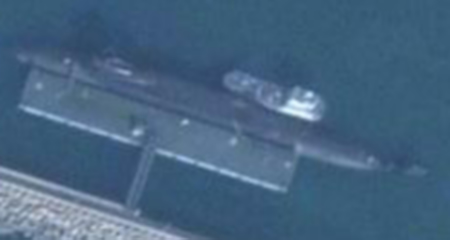 |
| The Xia-class SSBN appears to have completed a multi-year overhaul. The submarine has been in dry dock at least since 2005. Click on image to download large version. |
.
By Hans M. Kristensen
China’s single Xia-class nuclear-powered ballistic missile submarine has been launched from the dry dock at the Jianggezhuang Naval Base where it has been undergoing a multi-year overhaul. The Xia was discovered on a commercial satellite image, which shows the submarine moored in the harbor.
Multi-Year Overhaul
The Xia has been in dry dock at the base since at least 2005, when it was photographed by the Quickbird satellite. A new image, taken on December 5, 2007, and recently made available on GoogleEarth, shows an empty dry dock and the Xia moored on the opposite side of the harbor near the entrance.
|
Figure 1: |
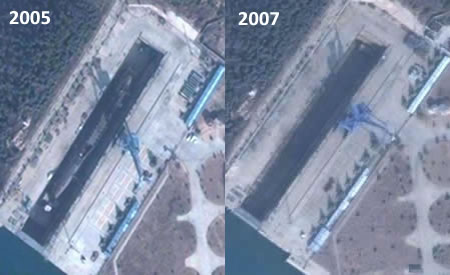 |
|
The Xia has left the dry dock at the Jianggezhuang Naval Base. Click |
Xia was originally designed with 12 launch tubes for the single-warhead 1,770+-km range JL-1 sea-launched ballistic missile. The Pentagon’s annual report on Chinese military forces lists “10-14” tubes, an odd number given that 12 were visible on the 2005 image. The resolution of the 2007 image is not good enough to count the tubes, but the number is probably still 12. Whether Xia will now finally become operational, serve as a backup for the new Jin-class, or be used as a test launch platform remains to be seen.
The image also shows what appears to be all of China’s five Han-class nuclear-powered attack submarines (SSN), the first of which are being retired and replaced with the Shang-class SSN. One of the five is a little longer than the others and could potentially be a Shang.
The Future of China’s SSBN Fleet
Whether Xia will finally become operational (it has never sailed on a deterrent patrol) or be scrapped remains to be seen. China has begun series production of the Jin-class SSBN, with possibly three launched and one deployed to Hainan Island in late 2007. The DOD has speculated that China might build up to five Jin SSBNs, if it plans to have at least one at sea at any given time. Britain and France each have four SSBNs, with one on patrol.
Background Information: other blogs about China | Chinese Nuclear Forces and U.S. Nuclear War Planning
Presidential Candidates Need to See Beyond Warhead Numbers

By Hans M. Kristensen and Ivan Oelrich
Barack Obama has put forward an inspiring nuclear security policy that promises to reinstate nuclear disarmament as a central goal of U.S. national security and foreign policy. This vision has been shared by all presidents since the Cuban Missile Crisis, except for George W. Bush.
If he is elected the next president, Obama’s policy would be a refreshing break with the gung-ho and divisive policies that have characterized the current administration.
Even so, it is important to consider the intent of Obama’s policy and look ahead to how it could be implemented and even improved.
The Role of Nuclear Weapons
The part of the policy that deals with existing nuclear weapons (versus proliferation) is very much focused on numbers. When both the United States and Russia clearly have far, far more nuclear weapons than either could conceivably need, it is tempting to ignore details and just make big cuts in numbers. But to move the process convincingly toward diminishing the salience – and eventually toward abolition – of nuclear weapons it is necessary to develop a vision for what role the nuclear weapons should play in U.S. national security policy. Short of some very general statements, Presidents traditionally leave this matter to the Secretary of Defense and the National Security Council. This practice has gotten us into a lot of trouble in the past as policy and military planners transformed vague presidential guidance into excessive and dangerous nuclear postures.
Other than a pledge to negotiate with Russia about ending high alert of nuclear weapons, there is nothing in Obama’s policy that suggests the role of nuclear weapons would be any different under him than under Bush or Clinton. Clearly, this is a shortcoming of his proposal. Statements from Senator McCain are even more worrying: he has said he will ask the military for a review and to report back on the minimum number needed, implying quite clearly that the military, not the president, will make important decisions about what role nuclear weapons ought to have.
The (first) Bush and Clinton administrations significantly changed the role of U.S. nuclear weapons from deterring and destroying Soviet and Chinese nuclear and large-scale conventional forces to deterring use and acquisition of all forms of weapons of mass destruction in all adversarial countries with such capabilities. Moreover, in response to 9/11, the Bush administration rushed forward a highly aggressive preemption doctrine that included nuclear strikes.
To change the role of nuclear weapons requires direct, sustained intervention by the next president. Therefore, both Senators Obama and McCain need to think hard about what his guidance would be on such issues as:
* Should the United States abandon its current policy of deterring all forms of weapons of mass destruction and only use nuclear weapons to deter use of nuclear weapons?
* Should the United States adopt a no-first-use policy or is it still necessary to retain the option to strike first?
* Should the United States retain counterforce targeting, return to countervalue targeting, or develop another concept for what facilities to target with nuclear weapons?
* Should the United States significantly lower and change the damage expectancy required for nuclear strikes?
* Should the United States abandon its policy of being capable of holding all potential targets at risk or is a more limited range sufficient today?
* Should the United States discontinue the practice of having nuclear weapons operationally deployed – including operating daily under a fully executable plan – or could sufficient deterrence be retained by a far less operational posture?
* Should the United States complete the 1991-1992 reductions and withdraw the remaining tactical nuclear weapons from Europe and instead rely on long-range weapons to provide a nuclear umbrella to our NATO allies?
|
No to No-First-Use |
 |
|
Defense Secretary William Cohen of the Clinton administration rejected a no-first-use policy. Will an Obama administration be any different? |
If the next president doesn’t address such fundamental policy issues in his first guidance, the outcome of the next Nuclear Posture Review will almost certainly be little more than status quo at lower levels, leaving in place a posture of excessive nuclear capabilities that the United States doesn’t need but which locks it into a warfighting deterrence posture that works against a vision for deep cuts and disarmament.
The End Goal
The component of Obama’s policy that deals with deep nuclear cuts and disarmament comes with important caveats. One is a pledge to “maintain a strong deterrent as long as nuclear weapons exist,” a position the Bush administration also shares, but which presents a particular conundrum for a policy that seeks nuclear disarmament: if all nuclear weapon states insist on having nuclear weapons as long as nuclear weapons exist, how can we ever get to zero? That would leave U.S. nuclear policy (and nuclear disarmament) hostage to any country that had just one nuclear weapons, even if our conventional capabilities are more than sufficient to deter anyone who can be deterred (Iran and North Korea being obvious examples).
At some point in the process, some of the nuclear weapon states – eventually all – have to be prepared to relinquish the weapons. This is not unheard of; Belarus, Kazakhstan, South Africa and Ukraine have already gone to zero. A “disarmament-president” has to think this conundrum carefully through.
Getting to deep cuts and certainly to global elimination of nuclear weapons might require wholesale revision of the role that military forces play in the world. The national security of the United States – and many other large military powers – is deeply rooted in a military posture aimed at threatening other countries if they do things we don’t like.
|
“As Long As |
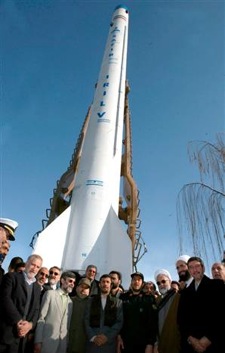 |
|
Would an Iran with a few nuclear weapons prevent the United States and others from going to zero even though they have overwhelming conventional capabilities? |
It is very hard see why other nuclear powers – some of which are our or other nuclear powers’ potential adversaries – would agree to move beyond deep cuts to actual nuclear disarmament as long as the United States pursues military superiority and unconstrained forward offensive operations. Would Russia and China agree to deep nuclear cuts when we’re developing conventional prompt global strike long-range weapons with hard target kill capability that can threaten their remaining forces?
Would Japan agree to the United States eliminating the nuclear umbrella as long as China modernizes and builds up it conventional capabilities? Would Israel agree to disarmament as long as they are surrounded by conventionally armed potential enemies?
Many government and military officials therefore effectively dismiss disarmament by saying: not until there is peace and brotherhood among men. In other words, certainly not in our lifetime or that of our children. Obama’s policy to some extend acknowledges this with a second caveat by talking about the “long road” toward elimination of nuclear weapons.
Ideally, these threats and insecurities must be addressed in a broader context of the relations between states and of the legitimacy of force but, no, all the world’s security problems do not have to be solved before we can consider the elimination of nuclear weapons. Three points are important particularly from a U.S. perspective.
First, there is no need to give some fifth-rate country like North Korea a veto over U.S. nuclear policy. North Korea may very well be developing nuclear weapons to deter the United States but that does not mean the United States, with overwhelming conventional military superiority, needs to have nuclear weapons to deter North Korea, even North Korea’s nuclear use.
Second, the nuclear disarmament of the big nuclear powers will make the nuclear disarmament of troublesome regimes like Iran and North Korea easier, not harder. Some Iranians talk of their nuclear program making them a “world power,” a conceit that would be completely laughable except the established nuclear powers do, in fact, often attach such significance to simply owning nuclear weapons. Delegitimizing nuclear weapons reduces their appeal. North Korea provides a different example: the United States, China, and Russia publicly claim that North Korea’s nuclear weapon program is intolerable, a concern that has only slowly impressed itself on the North Koreans. But imagine that China, the North’s only real patron, had eliminated its own weapons; would the Chinese tolerate their tiny neighbor’s nuclear program then?
Third, and probably most important, while global nuclear disarmament may depend on significant changes in the world’s attitudes toward the use and legitimacy of force, working toward nuclear disarmament can do much to bring about those very changes. Short of willingness to jumpstart the process by taking bold unilateral steps like big reductions in warhead numbers and success in changing the mindsets of all the nuclear powers and their allies, the “long road” might be very long indeed.
Despite these shortfalls, the nuclear policy Obama has put forward would, if it became U.S. policy, be a huge step forward in restoring traditional U.S. nuclear policy priorities and curtailing the role and salience of nuclear weapons in the world. By addressing the issues we have described, it could even be the beginning of the end for nuclear weapons.
Background: Obama’s Plan for a 21st Century Military | Missions for Nuclear Weapons After the Cold War
STRATCOM Cancels Controversial Preemption Strike Plan
 |
|
The controversial preemption strike plan CONPLAN 8022 has been canceled and the mission instead merged with the main U.S. strategic war plan. |
By Hans M. Kristensen
The U.S. military has canceled a controversial war plan designed to strike adversaries promptly – even preemptively – with conventional and nuclear weapons. The strike plan was known as Concept Plan (CONPLAN) 8022 and first entered into effect in the summer of 2004 to provide the president with a prompt, global strike capability against time-urgent and mobile targets.
CONPLAN 8022 was the first attempt to operationalize the “Global Strike” mission assigned to U.S. Strategic Command in January 2003. The mission was triggered by new White House guidance following the terrorist attacks in September 2001 and fear of proliferation of weapons of mass destruction.
Lack of leadership and definition has since placed Global Strike in limbo, with little progress and prompt effects instead being incorporated into other existing strike plans. “Global Strike” is now described as a much broader mission synonymous with the “New Triad” first articulated by the Bush administration’s 2001 Nuclear Posture Review.
CONPLAN 8022’s Short Life
Like its mission, CONPLAN 8022’s life was prompt and brief. STRATCOM completed the first version of the plan in November 2003, based on White House and Pentagon guidance issued in response to 9/11. The requirement was to develop a plan that could be used to strike high-value and mobile weapons of mass destruction (WMD) targets quickly with conventional or nuclear weapons before they could be used against the United States and its allies.
The Global Strike mission was formally assigned to STRATCOM in January 2003 and, in June 2004, Defense Secretary Donald Rumsfeld and CJCS General Richard Myers issued the “Alert Order” that ordered STRATCOM to put CONPLAN 8022 into effect. In July 2004, STRATCOM commander General E. Cartwright reported to Congress that Defense Secretary Donald Rumsfeld had “just signed the Interim Global Strike Alert Order, which provides the President a prompt, global strike capability” (see Global Strike Chronology for more details).
|
Figure 1: |
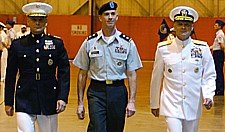 |
|
One of General James Cartwright’s (left) first acts after taking over as commander of STRATCOM in July 2004 was to withdraw CONPLAN 8022, developed by his predecessor Admiral James Ellis (right). |
Shortly after CONPLAN 8022 was brought up to full operational status, however, General Cartwright “withdrew” the plan in the fall of 2004, according to a document provided by STRATCOM in response to a Freedom of Information Act (FOIA) request. It is still murky what the term “withdrawn” implies, because several public documents and personal communication with STRATCOM continued to refer to CONPLAN 8022 after the fall of 2004. Cartwright has since declined to explain why he “withdrew” the plan, but his public statements in 2004-2006 suggest that he was concerned that the only actual prompt weapons in the plan were nuclear, and that this was not a credible posture.
As a concept plan, moreover, CONPLAN 8022 was not intended to be in effect continuously but designed to be brought into effect if necessary. After the plan was brought up to full operational status in 2004, it is possible that CONPLAN 8022 was “withdrawn” or returned to concept status once more. As of March 2006, STRATCOM told me, the plan “was still in its original version, with no revisions.”
But a year later, in July 2007, STRATCOM informed me that CONPLAN “8022 doesn’t exist.” When asked if the plan had been canceled or just deactivated, the officer said “there is no such plan anymore.” It “was underway, but didn’t go anywhere.”
|
Figure 1: |
 |
|
Even slow bomber deployments, like this B-2 deploying to Guam in 2006, are described as “Global Strike.” |
Global Strike Confusion
After cancellation of CONPLAN 8022 there has been significant confusion about what Global Strike actually is. After initially being “sold” as an urgent, unique and separate mission for limited, short-duration, quick-strike options against high-value and mobile targets not covered by other existing plans, Global Strike is now described as many things, ranging from Special Operations Forces raids (boots on the ground) to the traditional nuclear posture of long-range strategic nuclear weapons. Even slow bomber deployments are called Global Strike these days (see Figure 1 and 2; for an example of a recent Global Reach mission described as Global Strike, go here).
Some call it Global Strike, others call it Prompt Global Strike, while others again call it Conventional Prompt Global Strike, depending on who is talking and what weapon program is being promoted. General Cartwright sometimes tried to clarify the structure by saying Prompt Global Strike was a conventional subset of Global Strike, which was a subset of the strategic war plan. But his efforts seem to have had little impact on the debate.
|
Figure 3: |
 |
|
Slow B-52 bomber have conducted several Global Strike exercises, such as this quick-launch practice at Minot AFB in 2007, even though the platform is clearly not a prompt weapon. |
A recent GAO report found that the different Services and agencies have very different understandings of what Global Strike means. The varied interpretation of Global Strike, GAO concluded, “affects their ability to clearly distinguish the scope, range, and potential use of capabilities needed to implement global strike and under what conditions global strike would be used in U.S. military operations.” In response to the GAO findings, STRATCOM agreed to “develop a common, universally accepted concept and definition for ‘Global Strike’.”
Congress has been generally reluctant to fund new exotic weapons for the Global Strike mission. Future Years Defense Program (FYDP) planning has identified, according to GAO, 94 program elements that would provide funding for 135 programs, projects, and activities having possible application for Global Strike. But for now, more than five years after STRATCOM was assigned the Global Strike mission, the Department of Defense concedes that “global strike, as a validated and executable concept, has not matured to the point that it is an extant executable capability….”
Unfortunately, the GAO report only discusses the conventional aspects of Global Strike, even though it was the nuclear option that originally triggered Congressional interest in the mission. After I disclosed in 2005 that preemptive global strike options were being incorporated into a revision of the Doctrine for Joint Nuclear Operations (JP 3-12), more than a dozen members of Congress – including Ellen Tauscher and Jack Reed – objected in a letter to the president to what they considered to be a dangerous change of U.S. nuclear policy. Yet the nuclear option today remains the only executable prompt component of Global Strike.
“Global Strike” or just global strike
Despite the cancellation of CONPLAN 8022 and confusion over the Global Strike mission, however, planning for quick-reaction, short-duration strikes against high-value and fleeting (mobile) targets has continued at STRATCOM, officials confirm.
Instead of a separate CONPLAN, the Global Strike mission is being incorporated into the existing strategic war plan known as OPLAN 8044, offered to regional combatant commanders, and can probably also be found in the new Combat Weapons of Mass Destruction plan known as CONPLAN 8099. The combat employment portion of OPLAN 8044, previously called the SIOP (Single Integrated Operational Plan), was renamed in 2003 to reflect that the “single” top-heavy SIOP has been taken apart and converted into “a family of plans.” Compared with the SIOP, OPLAN 8044 includes “more flexible options” for potential use in a “wider range of contingencies,” according to military documents.
The “family of plans” is the result of a reorganization that has been underway since the early 1990s, when STRATCOM began to create “adaptive planning” missions tailored against rogue states armed with WMD. Back then, the first STRATCOM commander General George Lee Butler described how the SIOP was “evolving to a collection of far more differentiated retaliatory choices, tailored to a threat environment of greater nuance and complexity.”
The Bush administration adopted “tailored” as a central planning objective in its 2001 Nuclear Posture Review that ordering the development of a “New Triad” with more strike capabilities and options. Curiously, the offensive leg of the “New Triad” with its nuclear, conventional and non-kinetic strike capabilities has now become synonymous with Global Strike. Before CONPLAN 8022 was withdrawn, the Pentagon’s Strategic Deterrence Joint Operating Concept, for which STRATCOM was the lead agent, portrayed Global Strike as separate from nuclear strike capabilities (although it wasn’t). In the updated version from December 2006, however, Global Strike is portrayed as synonymous with the offensive leg in the New Triad (see figure 1).
|
Figure 4: |
|
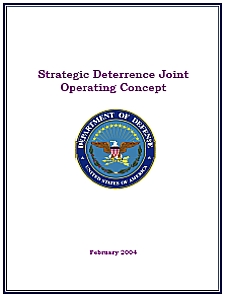 |
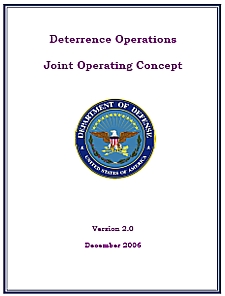 |
| “Direct Means” list (2004): – Force projection – Nuclear strike capabilities – Active and passive defenses – Global Strike – Strategic deterrence information operations – Inducement operations – Space control |
“Direct Means” list (2006): – Force projection – Active and passive defenses – Global Strike (nuclear, conventional, non-kinetic) – Strategic communications |
| Nuclear and non-nuclear offensive weapons have been merged under Global Strike in the 2006 STRATCOM-led Joint Operating Concept. The 2004 version, by contrast, listed the capabilities as separate. In the 2006 revision, however, the Global Strike mission description begins with nuclear and appear synonymous with the offensive leg of the “New Triad.” | |
To implement, maintain and execute the Global Strike mission, STRATCOM established the Joint Functional Component Command for Space and Global Strike (later changed to Joint Functional Component Command for Global Strike and Integration, JFCC GSI). The Concept of Operations document for the new command shows that its responsibilities reach far beyond Global Strike to all strategic strike planning for OPLAN 8044. Through JFCC GSI, STRATCOM is transforming its formerly secluded strategic nuclear strike enterprise into an integrated planning and strike service for national-level and regional combatant commanders. For JFCC SGI, that means integrating STRATCOM’s global strike capabilities into theater operations. A separate CONPLAN 8022 and OPLAN 8044, by contrast, would have constituted separation of planning.
STRATCOM’s current fact sheet on JFCC GSI – all that has survived from several pages previously posted on the command’s web site – shows a component command that has responsibility for the full range of strike capabilities in a planning architecture with Global Strike intertwined with traditional deterrence.
Some Implications
The Global Strike mission was launched with much fervor on the heels of a new preemption strategy following the 2001 terrorist attacks. But it is hard to take seriously the claim that Global Strike – meaning unique prompt strike capabilities other than those already in the inventory – is essential for national security when, more than five years after the mission was established, the Pentagon still hasn’t developed an executable capability or even a succinct definition for what Global Strike means.
In hindsight it seems that rather than developing a unique preemptive plan, planners have instead incorporated the concept into the remnants of the strategic war plan. This “integration” has become the guiding principle for military planning despite its slow start, and has reinvigorated the strategic planning community by creating requirements for an increased number of strike options and contingencies.
Mixed in with this morass of increasingly diffuse global strike capabilities are nuclear weapons, which ought to be clearly and unequivocally identified as a last resort that is separate from the dynamic Global Strike mission. The GAO report notes that “nuclear systems would be part of the portfolio” but doesn’t examine this part of Global Strike. Hopefully Congress’ Strategic Posture Review Commission and the next administration’s Nuclear Posture Review will.
Background information: Global Strike Chronology | Global Strike Concept of Operations | GAO: Strengthen Implementation of Global Strike
The RISOP is Dead – Long Live RISOP-Like Nuclear Planning
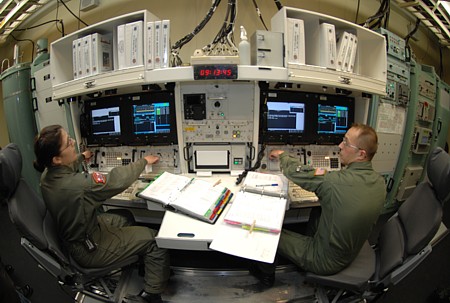 |
| Launch control officers at Minot Air Force Base practice launching their high-alert ICBM. But the hypothetical Russian nuclear strike plan that originally led to the requirement to have nuclear forces on alert has been canceled. So why are the ICBMs still on alert? |
.
By Hans M. Kristensen
The U.S. military has canceled the Red Integrated Strategic Offensive Plan (RISOP), a hypothetical Russian nuclear strike plan against the United States created and used for decades by U.S. nuclear war planners to improve U.S. nuclear strike plans against Russia.
The cancellation appears to substantiate the claim made by Bush administration and military official, that the 2001 Nuclear Posture Review removed Russia as an immediate contingency for U.S. nuclear strike planning. But implementing the shift was not a high priority, lasting almost the entire first term of the administration.
Despite the shift, however, declassified documents obtained under the Freedom of Information Act also show that RISOP-like and “red” analysis continues, and that that the cancellation was necessary to allow STRATCOM to broaden nuclear strike planning beyond Russia.
A Brief RISOP History
The RISOP dates back to the 1960s shortly after the first SIOP (Single Integrated Operational Plan), the Cold War name for the overall U.S. strategic war plan. An important element of refining and improving the effectiveness of the SIOP was to “wargame” it against the Soviet Union and more recently Russia. To do that, planners at Joint Staff and Strategic Air Command (SAC) developed a hypothetical Soviet War plan based on the latest intelligence about Soviet/Russian doctrine, strategy and weapons capabilities. To assist with coordination and planning, Joint Staff established the Red Planning Board (RPB), which included members of all the services and key agencies but was chaired by Joint Staff.
|
Figure 1: |
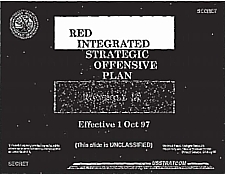 |
|
RISOP updates coincided with SIOP updates. The following declassified (heavily redacted) briefings show the content and structure of the 1996, 1997 and 1998 RISOP plans: * Joint Staff RISOP-96 Brief, April 1995 |
RISOP was based on the latest intelligence about Soviet/Russian nuclear strategy and forces, but the declassified documents show that Joint Staff and STRATCOM did not consider it an intelligence appraisal of those capabilities. Nor did it represent a judgment on the most likely Russian geopolitical intentions. Instead, RISOP was described as one of many possible and plausible courses of action based on Defense Intelligence Agency estimates of Russia force employment consistent with their military doctrine. But since planners probably didn’t want to wargame SIOP against anything but the “real” threat, RISOP most likely was the best possible estimate of the Russian posture.
RISOP was primarily a U.S. nuclear war planning tool. As a detailed opposing force threat plan, it was used by SAC and later STRATCOM in computer simulations to evaluate updates to the SIOP plan; RISOP updates coincided with SIOP updates. RISOP was also used to conduct force structure, arms control, and continuity of government analysis, and to carry out communications studies and prelaunch survivability computations and other strategic analysis.
The Slow Wheels of Change
Responsibility for production of RISOP was transferred from Joint Staff to STRATCOM in late 1996. The RPB was maintained, however, to ensure, among other things, that STRATCOM didn’t “cook the books,” as one of the declassified briefings put it. But the 2001 Nuclear Posture Review (NPR) changed the planning assumptions against Russia. Whereas the RISOP plans of the late 1990s (see Figure 1) envisioned Russian nuclear attacks against the United States, its allies, and China, those assumptions were clearly out of sync with the political and military realities in Russia. The NPR instead determined that “a [nuclear strike] contingency involving Russia, while plausible, is not expected,” and that the size of the operational U.S. nuclear arsenal is “not driven by an immediate contingency involving Russia.” Thus, the overall planning assumption shifted from urgent to plausible.
|
Table 1: |
|
Dec 2001: NPR completed
|
But despite statements about the importance of ending the adversarial relationship with Russia, changing the nuclear planning against Russia apparently was not a priority and would have to wait almost the entire first term of the Bush administration. The NPR was completed in late 2001, the NPR Implementation Plan published in March 2003, the new Nuclear Weapons Employment Policy (NUWEP) signed in April 2004, and a new Joint Strategic Capabilities Plan nuclear supplement issued in December 2004, formally removing the requirement for the RISOP. Finally, in February 2005, four years and two months after the NPR, the Chairman of the Joint Chiefs of Staff issued the instruction that formally cancelled the RISOP and the RPB (see Table 1).
Despite the policy change toward Russia, the RPB had not made any changes to the RISOP since 1998, following President Clinton’s PDD-60 directive that removed the requirement to plan for protracted nuclear war with Russia. As one Joint Staff official remarked in an email: “Sometimes the wheels of change move slowly.”
The “New” Nuclear Planning
The new planning guidance was laid out in the nuclear supplement to the Joint Strategic Capabilities Plan (JSCP), formally known as CJCSI 3110.04B or JSCP-N (see Figure 2 for earlier JSCP-N), which was published on December 31, 2004. This document instructed STRATCOM to “perform broader campaign level analysis than the previous requirement which focused on the RISOP.” In the words of the RPB, STRATCOM’s “red attack plan may also be broader than the scope of the RISOP.”
|
Figure 2: |
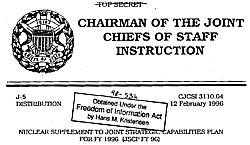 |
|
|
This broadening probably reflects the efforts to expand strike planning beyond Russia with increased focus on China and regional states armed with weapons of mass destruction (WMD). A “notable change” for the strike plan put in effect in March 2003 (OPLAN 8044 Revision 03) included executable strike options against regional states, options that were probably carried forward into the current OPLAN 8044 Revision 05.
Of course, Russia didn’t just disappear from the planning requirements. The NPR itself warned that although the country no longer is considered an immediate contingency, “Russia’s nuclear forces and programs, nevertheless, remain a concern. Russia faces many strategic problems around its periphery and its future course cannot be charted with certainty.” The NPR concluded that “U.S. planning must take this into account.” In addition, the NPR hedged, “in the event that U.S. relations with Russia significantly worsen in the future, the U.S. may need to revise its nuclear force levels and posture.” Relations have certainly not improved.
The previous JSCP-N from January 2000, which was updated in July 2001 (see here for chronology of nuclear guidance), required Defense Intelligence Agency (DIA) and Defense Information Systems Agency (DISA) to provide information to the Joint Staff for use in RISOP development. But the new JSCP-N moved this role to STRATCOM by directing that DIA and DISA “will support USSTRATCOM directly by providing data for red analysis.” The JSCP-N directs STRATCOM to perform three levels of analysis for the strike plans:
Phase I: Consequence of Execution Analysis
Phase II: Campaign Level Analysis
Phase III: Intelligence Assessment Analysis
Campaign Analysis is “a campaign level analysis to provide a stochastic check of the deterministic models used for the revision report consequences of execution analysis and to assess OPLAN 8044, REVISION XX’s [formerly SIOP] capability to comply with approved guidance. Such analysis will encompass various scenarios and may include the potential contribution of SACEUR’s MCOs [Major Combat Operations] as required.”
Despite the cancellation of RISOP, a 2004 STRATCOM briefing stated, STRATCOM “will continue to produce RISOP-like analysis,” and “procedures for requesting data and providing products will remain the same.” As before, use of the data will support prelaunch survivability analysis for ICBMs and bombers, base survivability of SSBN bases, and command, control and communication vulnerability and survivability analysis. All to ensure that U.S. nuclear forces will survive and endure against any nuclear adversary, including Russia.
Comments
U.S. nuclear forces were placed on high alert to counter the Soviet nuclear threat, and the effectiveness of the strike plan for their potential use continuously refined and improved by wargaming it against the RISOP. Now that Russia is not considered a nuclear threat and the RISOP has been canceled, how long will it be before the alert posture is canceled as well?
The U.S. strategic war plan – OPLAN 8044 Revision 05 – is currently structured around a reduced but more flexible posture with the same overall Triad structure as during the Cold War and over 1,000 nuclear warheads on high alert. Surprisingly, although RISOP was canceled in 2005, no revision has been made to OPLAN 8044 since October 2004 – the first time in U.S. post-Cold War nuclear history that the nation’s strategic war plan has not been overhauled at least once per year (see Figure 3).
|
Figure 3: |
 |
| STRATCOM has not published an updated U.S. strategic war plan since October 2004, breaking with a historical pattern of annual overhauls. The change probably reflects development of a new plan structure and more flexible adaptive planning capabilities. |
.
The explanation might be that major overhauls are no longer necessary because today’s plan has become flexible enough to accommodate changes on a ongoing basis without a need for a new revision; a “living SIOP.” OPLAN 8044 now consists of a family of plans applicable in a wider range of scenarios, with more flexible options to defeat adversaries in a wider range of contingencies than during the Cold War. Cancellation of RISOP might have reduced the focus on Russia, but it was also part of a broadening of nuclear strike planning to other potential adversaries.
The s l o w cancellation of the Russian-focused RISOP and the continuation of RISOP-like and red nuclear war planning for a broader and more flexible war plan should be an important lesson for the next president: unless he keeps his eye on the issue and pays continuous attention to how and when the military translates his initial guidance into a myriad of war planning requirements and strike options, the future U.S. nuclear posture – and with it the hope of significantly reducing the role and salience of nuclear weapons in the world – will only change v e r y slowly and not necessarily in the direction he had intended.
Chinese Nuclear Notebook Published
 A new Nuclear Notebook on Chinese nuclear forces has been published in the Bulletin of the Atomic Scientists. The notebook provides an unofficial overview of China’s nuclear-capable missiles, submarines and aircraft based on analysis done by Robert S. Norris (NRDC) and myself of Chinese and U.S. government documents, media reports, and other publications.
A new Nuclear Notebook on Chinese nuclear forces has been published in the Bulletin of the Atomic Scientists. The notebook provides an unofficial overview of China’s nuclear-capable missiles, submarines and aircraft based on analysis done by Robert S. Norris (NRDC) and myself of Chinese and U.S. government documents, media reports, and other publications.
The full article (PDF format) can be downloaded from here.